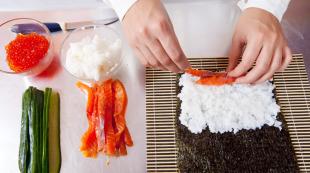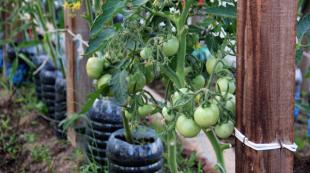How to properly tie tomatoes. How to tie up tomatoes in the open field
Indeterminate tomato varieties are more suitable for planting in a greenhouse - those in which growth is not limited. Therefore, it is so important to tie up the bushes for normal development and fruiting. The microclimate in the greenhouse itself contributes to the rapid growth of tomatoes. Culture loves high temperature and humidity. Tall varieties of tomatoes cannot be grown without the use of a support. If this technique is not used, the stem may break off under the weight of the fruit, or the plant begins to creep along the ground.
The garter facilitates plant care and improves breathability, thereby significantly reducing the risk of fungal diseases. The fruits begin to receive more light, which contributes to their accelerated ripening. A tied stem will not break off, even if many fruits form on it, and harvesting will be much faster.
The optimal time for tying a tomato in a greenhouse depends on their age and growth. According to the rules, this must be done when 8-10 true leaves are formed on the bushes, and the trunk in the lower part will have a thickness of 1 cm or more. This procedure also depends on the timing of ripening tomatoes. The garter is carried out:
- 35-40 days for early maturing varieties;
- 50-60 days for mid-season varieties;
- at 70-80 days for late-ripening species.
A feature of tall varieties is a powerful central stem and a highly developed root system, which requires frequent watering and top dressing at the root, so they should be tied up in such a way that there is no contact of the garter with water. Stakes 2.5-3 m high are installed along the edges of the beds, to which cords are attached, and then tomatoes are tied to them. As the stems grow, new garter cords are added.
If varieties of medium height tomatoes are grown in a greenhouse, they require more thorough care than tall species. The optimal garter scheme in this case is horizontally stretched cords, on which side shoots are fixed to give them the correct direction of growth.

The garter procedure requires compliance with a certain technology. You will need to follow the following procedure:
- pre-pasynkovanie bushes;
- choose an individual support for a specific type of tomato;
- prepare materials for work;
- to make a garter;
- water each plant.
It is better not to use synthetics or plastic as garters. The choice should be stopped on natural fabrics, but you need to remember that they are only suitable for one-time use. For a classic tomato garter, you will need:
- metal rods or wooden stakes;
- wire or twine;
- cut strips 3-4 cm wide of cotton fabric.
Attention! Fishing line or thin rope is not suitable for tying tomatoes. As the bushes grow, such material will dig into the stems and interfere with their normal nutrition. An incorrectly produced garter can easily ruin the entire crop.
Stakes are driven in from the north side of each bush and then the tops of the stems are tied to them with strips of fabric, making 2-3 turns around the peg. As the bush grows, it is necessary to move the garter higher, or use a new one.
How to tie up tomatoes in a greenhouse: video

On sale now you can find plastic lattice supports, specially designed for tying tall bushes. The fixtures are reusable and do not require any additional materials other than strips of cloth.
On a note! By the way, many summer residents successfully use old nylon tights for tying up tomatoes, which can be washed and used repeatedly.
The linear method is also quite convenient. In this case, strips of fabric are tied to horizontally stretched cords or wire opposite each bush, with which the tomato stalks are then fixed. In this case, re-tying the bush is not required, since during growth the shoots themselves will wrap around the rope.

The method using tapestries is considered reliable, but it is also the most technically complex. Each of the tapestries is a frame made of wood or metal with horizontal metal rods, or dense twine, stretched in the form of strings horizontally in increments of 30-35 cm.
As they grow, the shoots are simply woven between the stretched rows of twine, multiple brushes can be hung with plastic hooks from the same strings. With this method of tying, you can leave a few additional stepchildren, since the trellis is quite capable of holding even a powerful bush, and in this case the crop will be larger.
Useful tips when building a garter:
- It is impossible to tie the stem to the support with the "eight", in this case there is a risk of squeezing the stem and preventing it from developing normally.
- When forming fruits, also tie up brushes, this will make it possible to guarantee the preservation of the crop.
- For tall varieties, the trellis method of tying is more suitable. And for medium-sized ones - a garter using individual rods or stakes.
- Tie up tomatoes in a timely manner to prevent lodging of the stems and their contact with the soil - this way you will reduce the risk of late blight.
- Carry out the garter at the moment when the stem is just beginning to slope, do not allow it to be severely deformed.
- Always leave a gap of 1-2 cm between the shoot and the support, this margin will help the stem thicken unhindered.
If you have a large greenhouse, it makes sense to purchase a special device - a garter. The principle of its operation is the same as that of a stapler. The binder fixes the stem near the support with a special tape, which speeds up the procedure and eliminates the need for consumables.
Tomato garter in the greenhouse: video

The seedling is transferred to the greenhouse when it is strong enough, 8-10 leaves have formed on each bush, and the growth of the bushes is about 30 cm. For normal growth in a new place, it needs to provide suitable conditions.
Observe the temperature regime: during the day 25-28 degrees, at night not lower than 17-18 degrees.
Humidity should be at around 75%, this is facilitated by timely ventilation. Excess dampness inside the greenhouse can give rise to a lot of diseases in tomatoes. It is better to water the bushes in a basal way. If possible, install a drip irrigation system.
- Water should soak the soil to a depth of 15-20 cm. In this case, good contact of the roots with the soil will allow the plants to take root faster in a new place.
- Manual watering is carried out after drying the topsoil.
- Immediately after moistening, the ground around the tomatoes should be slightly loosened to provide oxygen to the roots.
- At the beginning of flowering, the watering rate is reduced to 1-2 liters per bush to curb the growth of green mass and actively form ovaries.
- When pouring fruits, watering should again become plentiful. The soil is watered every 2-3 days, soaking it to a depth of 20-30 cm. In the heat, watering should be daily.
The garter of the bushes is carried out on average 7-10 days after transplanting the seedlings into the greenhouse, using an individual or trellis method. If you do not remove the stepchildren, they weaken the bush and this negatively affects the amount of the crop.

Tall varieties need to be formed into one stem with the removal of all side shoots. And after the formation of the 7th fetal brush, the top of the main stem is also pinched. It is better to break out stepchildren with your hands - this way the plant is less injured. Medium-sized varieties are usually formed in 2-3 stems.
During flowering, it is necessary to help high-quality pollination of flowers. To do this, in windy weather, windows are opened in the greenhouse, creating a draft that mixes the pollen. Some summer residents lure pollinating insects into the greenhouse by planting honey plants there. You can pollinate plants artificially by shaking brushes or by pollinating them with a toothbrush yourself.
Contains potassium and phosphorus. Fertilizer is better to give on the leaf, in this case, the nutrients are absorbed by the plants faster. You can use superphosphate, potassium monophosphate and industrial complex fertilizers (Master Agro). Feed every 7-10 days. During the fruiting period, the bushes are fertilized under the root with slurry, chicken manure and superphosphate, alternating organic and mineral top dressing.
Helpful advice! From folk remedies, you can use yeast top dressing, a milk solution with iodine, an infusion of nettle and wood ash.
Treat the bushes with copper sulphate, foundationazole, phytosporin, using them according to the instructions. From folk remedies, you can use an infusion of garlic as a prophylaxis (1 kg of peeled garlic cloves in a bucket of water, leave for 7 days, strain and spray tomatoes).
Formation and care of tomatoes in greenhouses: video

When growing tomatoes in a polycarbonate greenhouse, there are some subtleties that directly affect the quality of the crop:
- Before each planting in the greenhouse, fresh soil should be added to the soil or replaced completely.
- Planting bushes in a checkerboard pattern can significantly save space by reducing the distance between rows to 40 cm.
- After watering, the greenhouse windows must be opened - this will prevent condensation on the walls and reduce the humidity level to normal values.
- in the morning or evening hours. The water temperature should be equal to the soil temperature.
- The introduction of root dressings should be carried out only after watering.
- Pasynkovanie bushes are best done in the morning, at this time the shoots are more fragile. In addition, until the evening, the wounds will have time to heal.
- To stimulate the formation of ovaries, the bushes are sprayed with a special preparation "Ovary" or a solution of boric acid (1 tsp per 10 liters of water).
- If the bushes look powerful and strong, but the formation of ovaries does not occur, then the plants have accumulated an excess amount of minerals. In this case, you should stop watering and increase the temperature to 25 degrees.
- During the ripening of the fruit, the soil should not be allowed to dry out, otherwise the tomatoes will crack, which will reduce their shelf life. The vents during this period should always be open so that oxygen enters.
- In order for the fruits to ripen faster, the bushes should be slightly pulled out of the soil before harvesting. For the same purpose, cut off all the leaves next to the fruit brush.
Growing tomatoes in a polycarbonate greenhouse is a painstaking and troublesome business. But if you follow all the rules of planting and care, any summer resident can grow an excellent crop.
So, let's try to figure out how to tie tomatoes in a greenhouse. Tying tomatoes is a simple procedure that involves attaching stems and branches to a support using ropes, strips of fabric, plastic loops and other materials. Tying is carried out immediately after pinching and the formation of fruit ovaries. When the plant increases in growth, the procedure will have to be repeated. Only some varieties that give undersized compact bushes do not need fastening.
You need to tie up not only the stems of the plant, but also branches with fruits. In some cases, it is worth fixing them in two or three places. You can not tightly tie knots, pull the plants too close to the support. If necessary, the mount can be removed and tied to the stem or branch in another place.
Benefits of the right harness
The correct garter of tomatoes in the greenhouse brings great benefits to the plants themselves, and also affects the result:
- Tomatoes do not tolerate moisture on the stems and leaves. Vertically standing plants can be watered under the root, which will help to avoid rotting and;
- Hanging tomatoes are easier to pick, they are not affected by late blight and do not fall prey to slugs;
- Heavy branches do not break even with a very large number of fruits;
- When tied up, plants receive more light and air, which accelerates the ripening of tomatoes;
- It simplifies the care of tomatoes: weeding, fertilizing, etc.
A photo
In the photo below you can see the tomatoes in the greenhouse garter:



What to use for fastening
securely fix tomato bushes can be used with supports and garter material. The role of the latter can be narrow strips of soft cotton fabric, cut nylon tights or stockings.
After harvest, the strips can be washed, disinfected and left for use next year. For tying, do not use thin twine, thread, fishing line, wire and other thin and hard materials that can cut or break branches.
Special devices with adhesive tape and a cutter are very convenient, resembling a hybrid of a garden pruner and a stapler. With the help of such a device, you can quickly and accurately fix the branches at the desired height. The tape can be easily removed and does not injure plants. The tape clamp is especially useful when tying tall tomatoes to trellises.
 Simple and inexpensive option- plastic clips, fastened with one movement of the hand.
Simple and inexpensive option- plastic clips, fastened with one movement of the hand.
They do not break, withstand any weight, are easy to clean and can be used for several years in a row. The clips are of different sizes, they can fix both stems and branches with fruits.
Tying options
So, what are the ways to tie tomatoes in a greenhouse? There are several of them. The choice of attachment depends on the variety, height of the bush, yield, type of greenhouse and other nuances.
You need to think over the attachment scheme even before planting seedlings, this will simplify the care of tomatoes and help avoid damage to the roots and stems.

 To choose the appropriate tying method, you need to try several options. capital structures they will cost more, but they will serve for several years without requiring additional devices.
To choose the appropriate tying method, you need to try several options. capital structures they will cost more, but they will serve for several years without requiring additional devices.
Not only tomatoes, but also cucumbers, tall eggplants and other large plants can be attached to such supports.
Mobile temporary mounts good for trial growing and frequent change of vegetable crops in the greenhouse.
Useful video
Watch the video below: garter tomatoes in a greenhouse
If you find an error, please highlight a piece of text and click Ctrl+Enter.
Related ArticlesWhat gives a garter
The method of gartering greenhouse tomatoes depends on the height of the plant and its power. The easiest way is to use an individual peg for each bush. Any material is suitable for this - fittings, metal rod, wooden rail or plastic pipes. The length is selected based on the height of the bush plus a margin of thirty centimeters. For this difference, the stake is driven into the ground a few centimeters from the bush. After that, the garter is performed. It should be noted that this option is suitable for medium-sized species. Large bushes with their weight are able to overturn the peg. There is also a minus - as the plants grow, the garter is performed several times.
- The material for tying tomatoes should not cut into the trunk of the plant, should not damage it in any way.
- Seedlings are planted in the ground in May-June, depending on which region you live in. In any case, the risk of returning frosts should be minimal, or be prepared to cover the tomatoes with a covering material.
- For 1 bucket of such a soil mixture, add a liter jar of river sand (and preferably vermiculite) and a tablespoon of ash and superphosphate.
- The tomato tying procedure is a crucial moment in the cultivation of tomatoes, which should not be ignored. Caring vegetable growers use it not only for tall varieties. Low-growing tomatoes with this method of growing get sick less and give excellent yields.
- Growing vegetables is a fun activity. Amateur vegetable growers place a wide variety of crops on their plots. But none of them is complete without juicy and tasty tomatoes. A variety of tomato varieties will require an individual approach to each of them when growing. Low-growing tomato species are compact bushes that do not require special agricultural practices. But is it possible to resist the temptation of growing large-fruited varieties of tomatoes? They have incomparable taste. But at the same time, such vegetable crops will require more attention than undersized relatives.
- If the bed is long, then it will be necessary to strengthen the structure by driving in additional intermediate stakes, then no wind will be terrible for your garter. And if you plant 2 beds parallel to each other at a short distance, then the design will come in handy for tying tomatoes from both at once: you will get a kind of tomato hut.
- For low and medium-sized varieties, you can choose materials 20-30 cm above the seedlings, but tall ones will require longer stakes - up to 2-2.5 m.
- With the development of horticulture, the breeding of new crops by breeders and the invention of modern materials, several methods of gartering a tomato when grown in open ground have appeared and taken root in vegetable growing. Each of them has proven its effectiveness in practice, so you can safely choose any that is convenient for you and your summer cottage. You may even be able to invent something of your own based on them, so let's take a closer look at each option on how to properly tie up tomatoes.
It is also much easier to carry out other procedures for caring for seedlings in the open field: mulching, hilling, weeding, pinching
No matter how strong the stem is, all gardeners recommend tying tomatoes in the open field. Any varieties of tomatoes require timely garters, and especially tall ones - those that reach 2 meters in height. Low-growing varieties are often not tied up at all, but the proportion of their cultivation compared to taller varieties that give a more abundant harvest is constantly decreasing, because everyone is striving for the expedient use of every square meter of land on the site. Therefore, with the same care, labor costs and planting area, high varieties are more rational and cost-effective than their low counterparts.
Ways
A convenient method is to tie a tomato in a greenhouse to a trellis. Strong supports are installed in the bed, on which a wire or a strong rope is pulled. As the bushes grow, their stems are tucked behind the wire according to the principle of weaving. And you can stretch the wire only along the upper sections of the supports, and tie the bushes to it with twine. It remains only to direct the bush as it grows around it, so that it wraps itself around it.

Now, with regard to pinching tomatoes in the open field ... A lot depends on the region - if you have a warm climate in which the fruits even on stepchildren have time to ripen before the cold weather, then of course you can not pinch the bushes. If the summer is short, it is better to pinch, that is, break out the side shoots growing from the axils of the leaves, or at least pinch to the first flower brush. Read more about this in the article on how to properly pinch tomatoes. When planting seedlings in the ground, the plant is carefully removed from the cup and placed in a prepared hole, which is preferably pre-spill with warm water. The plant is lowered into the hole to the cotyledon leaves and sprinkled around with earth, compacting it a little. Now we pour the prepared soil into the boxes, compact it a little and sow tomato seeds. Sprinkle more soil on top, about 0.5-1 cm. If the sowing depth is less, sprouts may appear with a seed coat on them. (In this case, do not tear it off, but drip it with water and a little later the seed will be removed easily). The soil after sowing must be watered from the sprayer. 
Growing tomatoes in the open field includes sowing seeds for seedlings, growing seedlings, planting seedlings in the ground, caring for adult plants and harvesting. 
stakes
There are many varieties of tall tomatoes. They differ in color and size of fruits, which are distinguished by excellent taste. However, growing them is a rather troublesome business. But for the sake of getting large-fruited tomatoes, it is worth working hard. As a rule, vegetable growers grow seedlings of tall tomatoes on their own. For its landing, the land has been prepared since autumn. For tomatoes, well-lit areas with fertile soil will be required. The beds are planned in such a way that it is possible to carry out the necessary agrotechnical measures, during which one cannot do without tying tomatoes. Novice amateur vegetable growers make mistakes when fixing plants.
With a little effort, you can design entire structures for the garter that will last you for a single year. These will be original cells for vegetables. They are built separately for each bush. First, several circles of the same diameter are made of dense reinforcing wire, then they are fixed at the insistence of each other on vertical racks of the same wire. It turns out a cylindrical wire cage, which is installed at the same time as the pegs, and then, as the bush grows, you only need to tie the stem in time.
Each of the pegs should be strengthened in the ground so that it holds firmly, usually deepened by 20-25 cm, retreating from the stem of the tomato by about 10 cm, so that the root system is not accidentally damaged by you. You need to tie the tomato loosely, it will be right to first fix the string on a peg, then wrap the stem around and tie. As the vegetable grows, we perform this process several times. 
On the trellis
To begin with, we note that any of the methods listed below use materials that do not harm the plant, so follow the tips and you will never have problems growing tomatoes.
- Tying a tomato stem will simplify watering, because, based on the correct growing technology, the vegetable does not welcome excess moisture on the leaves, so it is better to do any water procedures near the root.
- A tomato garter is not a tribute to garden traditions, but a “production necessity”. This simple procedure has a lot of benefits for your future harvest, namely:
The most commonly used method is individual support pegs. Some gardeners install trellises, but in this case, the wire is replaced with wooden slats, giving it strength and stability in case there is a strong wind.
Growing a garden crop involves knowing certain subtleties. Just planting seeds in the ground will not bring anything - you need to make an effort to get results. Tomato bushes are one of the most demanding types of crops; they imply the implementation of measures that contribute not only to improving yields, but also to preserving vegetables. Today we will consider one of these questions - how to properly tie up tomatoes, a step-by-step description, a photo.
Cells
The scheme for planting tomatoes in the open field depends on the planted variety: early ripe tomatoes are usually planted according to the scheme 30x40 cm, late ones - 50x50 cm and on the method of formation of the bush. 
To speed up the emergence of seedlings, plantings can be covered with a film. As soon as shoots appear, the film must be removed.
Caps
In this article, we will tell novice gardeners in detail how to grow tomatoes in the open field.  What is the correct tomato garter? Tall plants, depending on the variety, will require pinching and regular stem fixation. The tomato garter procedure is performed 3 to 6 times per season. At the same time, this agricultural technique is performed for each plant individually.
What is the correct tomato garter? Tall plants, depending on the variety, will require pinching and regular stem fixation. The tomato garter procedure is performed 3 to 6 times per season. At the same time, this agricultural technique is performed for each plant individually.
Video "Garter of tomatoes"
If you can’t find the wire, then you can build a similar frame out of wood, fastening the stakes together like a stool, only without a seat. If you make such a cage wide enough, then it is able to cover 4 bushes of tomatoes - for each "leg" of the structure. This is much more reliable than driving in individual pegs.
plodovie.ru
Ways to tie tomatoes when grown outdoors
If you have a tomato plantation, it would be more rational to use a different garter method. It will require a thin beam or strong pegs, and their number is much less than in the method described above. We drive in the racks at the beginning and end of the tomato beds, we stretch the wire between them. With this method, you will need to tie the stem of the tomato to a stretched wire. You can tie up a plant like this if you planted a tall variety of tomato, and using a stretched wire is available in several options: 
The twine, which you will use as an improvised tool in order to tie up tomato bushes, cannot be tightened tightly so that it does not crash into the stem of the plant.
Tying up the stem will keep the fruit some distance off the ground, so your crop won't become a dining room for slugs or mice. 
The stem will not bend and break as it grows and under the weight of the fruit, so its vitality will not be used to fight for survival, but will only be aimed at a good harvest.
It is important to choose the right dressing material that will be in direct contact with the plant. It should be strong and of good width. Wire, nylon fishing line, thin twine - all this should be set aside, as the materials will cut into the stem, damaging it.

It should be warned that not all tomato varieties need tying. Shrubs of low growth and quickly ripening do without it, but tall species need a garter.
Tomato care includes timely watering, weeding, top dressing, garter, pinching and, if necessary, disease control.
fb.ru
Growing tomatoes outdoors
Boxes with seedlings should stand in a very lit place. If the seedlings begin to stretch, then it does not have enough light. In this case, fix additional lighting above the landings, 1 40 W fluorescent lamp is enough for 1 square meter. If there is no way to hang the lamp, you can compensate for the lack of lighting by applying potash fertilizers.
The approximate time for planting your tomato variety is indicated on the seed bag, and the most favorable dates for this can be found if you look at the lunar calendar for gardeners.
Spring planting of tall tomato seedlings differ from low-growing varieties. Bushes of individual species can reach 1.5 meters in height. Therefore, plants are planted at a distance of 1 meter from each other. After planting tomatoes, they select material for tying tomatoes.
Unusual designs and convenient designs of a different kind - caps. They are suitable for tying not only a tomato. The bottom line is that you need to build a tall narrow "wigwam" or a pyramid from improvised means.
Pull a strong wire onto a high beam at a level of about 2 m - then the strings for the garter should be long enough to reach both the support (wire) and the stem. Tomato lashes will wrap around these ropes as they grow;
For fastenings, any fabric torn into strips, twine or other type of rope will do. Wire or fishing line will not work at all, because it can cut deep into the stem and irreparably destroy it.
Excessive soil moisture will not harm the ripening of the fruits if they are not located on the ground, so the garter will keep the vegetables from rotting on the branches.
With a vertical arrangement of the tomato bush, it will be as open as possible to sunlight and fresh air, so it will develop sufficiently, because the plant loves the sun and will give an excellent harvest.
When performing pinching of bushes, this is best done when they are tied up. Plants of high growth also need a garter because an abundance of fruits can break the main stem of a bush.
Watering tomatoes should be carried out on average once a week, but this is very dependent on the weather, this is the difference in growing tomatoes in a greenhouse and in open ground - it is impossible to control watering.
Planting a tomato in open ground
When the plants have two true leaves, the seedlings need to dive (seed), that is, carefully remove the plants from the common box and plant each in a separate cup - the roots need more space to grow. First, pour an incomplete glass of soil, it is better to add it later as the plant grows, so that additional lateral roots form on the stem.
In any case, tomato seedlings are planted in the ground at the age of 55-60 days. Estimate approximately when the last return frosts in your area, subtract 60 days, add 5-7 days for seedlings and get an approximate time for sowing seeds for seedlings. Usually this is the end of February - the beginning of March.
This will require, first of all, twine, which should be quite soft and elastic. Wire or fishing line should not be used for this purpose. They can damage plants. Tomato garter pegs should be of sufficient height, fairly strong. Usually these are wooden or metal pegs that can be used for several seasons in a row. The material for the garter of tomatoes is ready. As the plants grow, they begin to fix them. You shouldn't be late with this. Bushes that touch the ground are prone to diseases and, as a result, lag behind in development and bear fruit poorly. This will lead to crop loss and a decrease in the quality of vegetable products. The garter is made immediately to permanent pegs that will serve the plant all season. Fixing a tomato bush is easy. A support is installed near each bush. It must be strong enough. The fixation of the plant should not be rigid, and take into account the fact that as the tomato stalk grows, it will thicken. Tomatoes are tied with a soft rope or fabric ribbons. Twine several times (in the form of a figure eight) wrap the stem of the plant and the peg. Then it is fixed on a peg. A free loop is formed between the plant and the peg, which does not interfere with the growth of the plant. As they grow, they carry out repeated garters of tomatoes.
Caring for tomatoes in the open field
It can be wire, vine or stakes in a cross-knit warp in the form of a cage. Install similar caps along with planting seedlings, and they are useful for tying several bushes at once. Such pyramids should be placed at some distance from each other so that there is no crowding of plants, usually it is 1 meter or a little more if the site allows.
Stretch several rows of wire, fixing them on the beam. Then each bush will need to be tied up separately several times to the formed stretch or pass the stem through the horizontal stripes as it grows, so that the braid comes out of the tomato.
Natural fabrics are good, but not entirely acceptable for open ground, because. can rot and fall off, but even worse, become an incubator for a pathogenic infection. Therefore, we will choose something synthetic, but not too thin to tie up the stem. By the way, you can use materials for gartering grapes. In any case, the rule applies: you choose the garter material for one year, and then throw it away so as not to transfer a possible infection or disease to new seedlings next year.
Garter tomato in the open field
It is, based on the above positive aspects of the tomato garter, experienced gardeners never forget about this stage of growing a vegetable.
Inevitable rains and downpours will not be able to damage the tomato in the open field if it is securely fixed on an additional support.
If you have chosen a garter material that you hope to use for several years in a row, do not forget to disinfect it with boiling water to evaporate pathogens that have accumulated in the fabric in the previous season.
tomatland.ru
How to tie up tomatoes step by step description, photo | Merry Harvester
The need for this event
- When the seedlings take root, it is best to mulch the soil with straw, so it will be much easier to keep the soil moist, and the weeds hardly grow. There is no crust under the straw and therefore loosening is not required. A sort of lazy way of growing tomatoes.
- A couple of weeks before planting seedlings in open ground, they begin to harden it. If possible, move it to a cooler, but not cold, place. Reduce watering.
- The soil for growing seedlings can be taken purchased, already prepared, or you can prepare it yourself. To do this, mix 1 part of sod land, peat and humus.
- No less effective is the trellis method of growing tall varieties of tomatoes. To do this, a trellis is built along a row with planted seedlings. Metal stakes are installed on both sides of the row. Several rows of twine are fixed on them at different heights. Growing plants will be securely fixed on such a trellis.
in the greenhouse
A record of how easy it is to tie up tomatoes with a dense thread without harming the plant.
You can buy tomatoes in the store, but not everyone is pleased with the taste and prices. Well, there is no need to talk about the environmental friendliness of such products. Therefore, many people prefer to grow vegetables on their own. And in order for the invested work not to be in vain, it is necessary to take into account the peculiarities of growing each crop.
In the case of tomatoes, it all starts with the choice of variety. Given the climatic zone and natural conditions, species are selected that will be most resistant to drought, or damage to fungus and viruses. In terms of taste, domestic analogues win in comparison with foreign ones.
Why you need to tie tomatoes
To obtain high yields of tomatoes with excellent taste, it is most profitable to plant tall varieties with large fruits. In such cases, if you do not take care of the garter in advance, the losses will be significant - the branches may break under the weight of the fruit or grow weak and prevent the tomatoes from fully forming.
 Most often, stakes and ropes are used - this is the simplest option that does not require serious costs and time. It all depends on the planting area, variety and personal situation. Sometimes not only purchased twine and twine are used, but also straps, ribbons, laces, old stockings and tights. The main thing is that the material is not too tight and does not cause serious deformation to the stems. Near each bush is driven in
Most often, stakes and ropes are used - this is the simplest option that does not require serious costs and time. It all depends on the planting area, variety and personal situation. Sometimes not only purchased twine and twine are used, but also straps, ribbons, laces, old stockings and tights. The main thing is that the material is not too tight and does not cause serious deformation to the stems. Near each bush is driven in
For those who are accustomed to approaching everything with all seriousness, trellises are suitable. This is a series of stakes, between which a wire or a completely metal frame is stretched. Stakes can be wooden, metal, plastic. A wire is stretched horizontally on them with a distance of 45 cm between rows.
stake and as the plant grows, it is tied to it at the top level.
Important!
Sometimes it's better not to use everything that comes to hand. Thin wire, fishing line and too narrow a rope are not suitable for tying. They can cause injury or pinch the trunk and branches. It is also worth carefully using stakes and garters left over from last year to exclude. If there are no other options at all, be sure to treat them with an antiseptic.
Tying options:
trellis growing
 This method is well suited for large areas and tall varieties. Tapestries are assembled in a variety of configurations - from metal, wooden stakes and even bamboo sticks. This is usually a cumbersome design requiring material costs and installation time. But the likelihood and reduction in cases of diseases more than pay for the trouble of installation.
This method is well suited for large areas and tall varieties. Tapestries are assembled in a variety of configurations - from metal, wooden stakes and even bamboo sticks. This is usually a cumbersome design requiring material costs and installation time. But the likelihood and reduction in cases of diseases more than pay for the trouble of installation.
The simplest option is stakes or pipes driven into the ground at different ends of the beds and a wire or a crossbar stretched between them along the top. If the row is longer than 5 meters, then intermediate supports are driven in between the end supports, approximately at a distance of 4 m. The height depends on which variety will grow, if medium-sized, 1.2-1.5 m is enough, for tall tomatoes it is already necessary provide for 2.5 m and above.
The design can be the most common - at right angles or inclined V, A, or X shaped. Usually, wooden or bamboo posts are used to create curly ones, and metal ones are also well suited for rectangular ones.
 Suitable for both greenhouses and open ground. In the first case, in addition to twine, you may not need additional materials, since you can use the frame of the greenhouse structure for supports from above. If several rows are planted, and there are few transverse slats, it is still possible to stretch the wire, on which bushes can also be tied.
Suitable for both greenhouses and open ground. In the first case, in addition to twine, you may not need additional materials, since you can use the frame of the greenhouse structure for supports from above. If several rows are planted, and there are few transverse slats, it is still possible to stretch the wire, on which bushes can also be tied.
For open areas, a frame should be created in order to be able to attach the rope from above using the free loop method. These can be stakes on the sides and a cross-stretched wire between them at the highest point in order to be able to secure the upper end of the twine or rope. The lower end is attached around the stem closer to the base or middle, but not near the top.
The construction can be very different - from wood, plastic, metal, bamboo sticks, using twine or wire. The main thing is that the garter is carried out using the free loop method, which allows for good tension and ease of regulation as the tomato bush grows. In this case, horizontal support rails are not required, one twine is enough, stretched vertically and fixed on both sides.
Good simplicity and accessibility, because it does not require large expenditures on materials and complex devices and structures.
More accessible can be seen in the video.
On the grid
 The mesh can be made of a variety of materials - metal, plastic, wire, rope, sometimes wooden bars. The main point is that the support area is as large as possible and allows each branch to be fixed. It is very similar to the trellis, but unlike the trellis method, the grid cells are smaller than the distance between the crossbars. Often the mesh is bought ready-made and installed already on the site. Sometimes the mesh can be soft and cut into small pieces under each bush, if they do not grow too wide and are not planted too closely.
The mesh can be made of a variety of materials - metal, plastic, wire, rope, sometimes wooden bars. The main point is that the support area is as large as possible and allows each branch to be fixed. It is very similar to the trellis, but unlike the trellis method, the grid cells are smaller than the distance between the crossbars. Often the mesh is bought ready-made and installed already on the site. Sometimes the mesh can be soft and cut into small pieces under each bush, if they do not grow too wide and are not planted too closely.
For wire frame
Unlike the previous version, a wire frame is installed on each bush separately, and not on the entire row. A flexible mesh is wrapped around each bush and gradually wrapped around new shoots as they form. It turns out a kind of "house" or cage, inside which tomatoes ripen. Quite a costly method and is unlikely to be suitable for large farms.
Line Mount
 It looks like a trellis tying, but in the case of a linear fastening, additional ones are not driven in between the vertical stakes at the ends. Ropes or strips of fabric are tied with one end to the base of the bush, and the other to the rope at the top. The undoubted advantage is that as the plant grows, it will no longer need to be adjusted and re-tied, it is only important to wrap new shoots around the rope in time. Do not use this option for tall varieties with large fruits.
It looks like a trellis tying, but in the case of a linear fastening, additional ones are not driven in between the vertical stakes at the ends. Ropes or strips of fabric are tied with one end to the base of the bush, and the other to the rope at the top. The undoubted advantage is that as the plant grows, it will no longer need to be adjusted and re-tied, it is only important to wrap new shoots around the rope in time. Do not use this option for tall varieties with large fruits.
To individual support
You don’t have to build complex structures, some will like the simple way, which uses stakes that are driven in near each bush. As a garter material, you can use patches of fabric, yarn, twine or rope. The height of the stakes should be selected a little higher than the expected height by about 20-25 cm.
For all its simplicity and accessibility, it is important to take precautions - wooden supports are used only once, and materials that can be washed or treated with an antiseptic must be processed before the next use. So the possibility of infection with last year's lesions is minimized.
Common mistakes when tying a tomato
- too tight loops when tying can injure the stems and affect the development of the bush;
- an incorrectly chosen method reduces productivity and adds unnecessary trouble;
- neglect of security measures;
- the use of last year's materials leads to the development of diseases.
If you decide to tie up tomatoes, then it is better to prepare in advance, and not to establish supports between already formed plants. In most cases, regular correction of the garter is necessary along with the growth of the shoots, otherwise the branches may break off and growth will stop. It is important to ensure that stepchildren do not develop strongly and remove them as they appear.
It is necessary to tie up tall varieties growing in greenhouses. Medium-sized and undersized in the open field sometimes may not be tied up, especially if they grow in the southern regions, where it rarely rains.
Tomatoes are a traditional crop grown in gardens and cottages. Despite the fact that the choice of these ripe fruits in the store is quite wide, many people prefer homemade tomatoes. Among the varieties of this culture, there are tall, short, medium-sized plants, but most often summer residents opt for the former.
But when growing such tomatoes, you need to know how to tie tomatoes. Tall tomatoes are cultivated both in greenhouses and in open ground. Despite the fact that these plants are more capricious and require careful care, they are loved for their large and tasty fruits. One of the important stages of growing tomatoes is the garter. Therefore, in order for tomatoes to grow better, it is important to know how to properly tie up tomatoes.
Garter Rules
Abroad, in open ground, tomatoes are often grown without a garter, the stems lie on the ground. This method of growing tomatoes is favored by the hot southern climate. In our latitudes, untied lying bushes in the open field will quickly begin to rot and hurt, and summer residents who use this method risk being left without a crop. Therefore, it is better to tie them up. Garter tall tomatoes in the open field has a lot of advantages.
- Firstly, it greatly facilitates watering and fertilizing, since tomatoes do not tolerate water on the tops, and even more so that the solution intended for the roots gets on it.
- Secondly, tied plants are well ventilated and dried after rains, so they are less likely to get late blight and other diseases. Humid warm environment is favorable for the development of diseases.
- Thirdly, the fruits on the tied bushes are illuminated more evenly, which means they will ripen faster. But in order not to damage tall tomatoes in the open field when tying, you must follow simple rules. In general, they relate to the choice of materials. For tying, do not use wire, fishing line, thin rope and other similar materials. They will cut into the stem and damage it. Thus, the plant will begin to hurt, and bacteria and various pathogens will quickly penetrate the wound.
Garter material is best used synthetic, such as nylon stockings or tights. You can also use a thick nylon cord, rope or twine. Such materials will not rot. Plants should not be tied tightly, the rope should hold the stem, but not dig into it. Do not use last year's garter material, as pathogens or bacteria may remain in it. It is necessary to tie up tall tomatoes only in proven ways.
Ways to tie a tomato
Proper tying should provide soft but firm support, and should not damage tall outdoor plants. To do this, you need to use the proposed methods.
Garter for pegs
This is a long-tried and proven method that provides reliable support for weak stems of tomatoes. To tie tomatoes on pegs, you need to choose several stakes of a size corresponding to the declared height of the plants. Then the garter material is cut from the rope or cords.
Near each bush, one peg is driven into the ground; it can be wooden or metal. The garter material is pre-disinfected by boiling in water. The stem of the tomato is tied up near the top. The rope must be loosely wrapped several times and tied into a knot. In the process of growing a bush, the rope can be moved up or another garter can be made, and the old one removed.

tie for trellis
Tying to a trellis will securely fix tall tomatoes in open ground and will prevent them from falling. A simple trellis is easy to make with your own hands. To do this, you need wooden supports, nails, wire and slats. As a support, you can use a wooden or metal column in the amount of 3 pieces.
The height of the column should be approximately 3.5 meters. So that after installation, the height above the ground is 3 meters. Supports are installed in one row with an interval of 4 meters. In the upper part of the supports, slats are installed, pinned with nails. Then, along the supports, the wire is pulled in three rows with an interval of 1 meter. Thus, a horizontal fence of three wires should be obtained.
The lowest wire is installed 20 cm from the ground. After installing the frame from a nylon rope, you need to weave a mesh with cells. To do this, a rope is wound on the wire every 20 cm. You need to make a trellis before planting tomatoes. Then they are planted to the trellis and, as they grow, they are directed upwards.
Linear way
This is another version of the trellis garter, but simpler. In the same way as in the previous version, supports are installed, and the wire is pulled in one row. Above each plant, a rope is tied to the wire to secure the tomato stems. The other end of the rope is wrapped around the stem and tied. It is not necessary to tie up such tomatoes, as the stem grows, it is necessary to wrap it around the rope and it will be securely fastened.
Using cages for tomatoes
To fix tall bushes in the open field in this way, you need to make an individual cage for each of them. It is made of hard wire and metal arcs. The arcs are bent and installed on planted bushes, then they are connected with wire. The planted plant is tied with a rope to the cage frame.
Another option is landing in pyramidal caps, which are made from 4 rods. This cap is designed for 4 plants. It is dug in when planting tomato seedlings, and the tops of the rods are connected with wire.
Hook garter
This method is somewhat similar to a garter to a trellis. High stakes are dug along the edges of the tomato beds. A wire is pulled between them, every 30 cm a fishing line with rings and hooks is tied on it.
Hooks are used to attach tomato stems. This method is quite effective, but time-consuming and inconvenient to use, so it is not often used.
By tying your tomatoes in any of the proposed ways, you can be sure that they will be securely fastened and will not fall.









